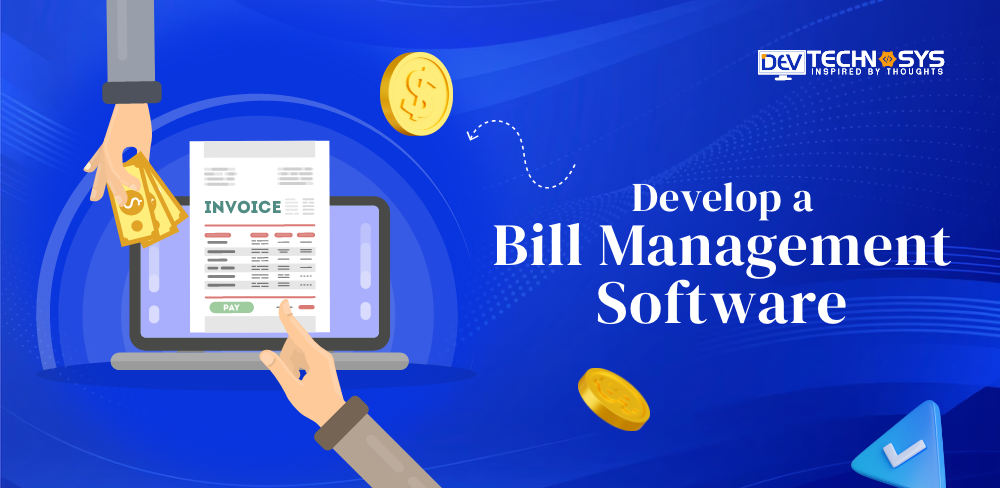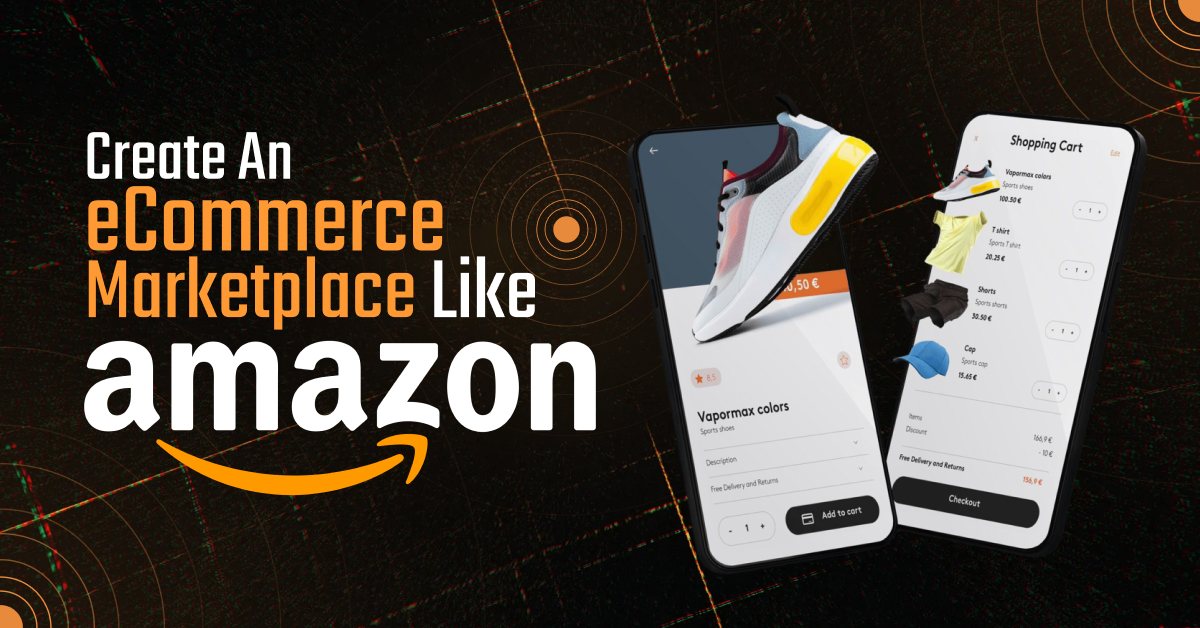“In the realm of business, crafting efficient billing management software is not just a solution; it’s the alchemy that transforms chaos into financial harmony.”
Quick Summary: Creating invoices can be a time-consuming and intricate task for businesses, taking up valuable hours and days. Implementing efficient billing management software can significantly reduce this time investment. Our guide outlines the steps for billing management software development to streamline the invoicing process and minimize the complexities associated with billing.
Running an offline business on a large scale becomes hectic when you must keep an eye on the buying and selling process, managing multiple bills simultaneously. Even a minute billing error can disrupt the entire financial calculation, and none of the businesses can afford it. Right?
So, to overcome this issue, bill management software development comes into the picture. From organizing, tracking, and paying bills, well-developed billing software can savour all-scale businesses.
With the increase in online and real-time transactions, the billing process has become a little hectic, and hence, businesses have to struggle to manage all the billing. So, to overcome all the billing woes, the urge to develop billing system software has been raised. A good billing system is beneficial for businesses as it ensures customer satisfaction and, in turn, increases business growth and sales.
Whether you’re a small business owner or part of a larger organization, having the right system billing software can make a big difference in your day-to-day operations. This blog will guide you through the steps to develop billing management software and help you understand what you need to know to get started.
What is Bill Management Software?
Bill management software is a specialized system designed to streamline and automate invoicing while organizing and tracking business billing. The best invoice-tracking software centralizes financial information, allowing users to manage various aspects of their bills via a single platform.
Bill management software development exclusive features, including automatic bill reminders, expense categorization, and payment schedules, help users avoid late fees and maintain financial discipline.
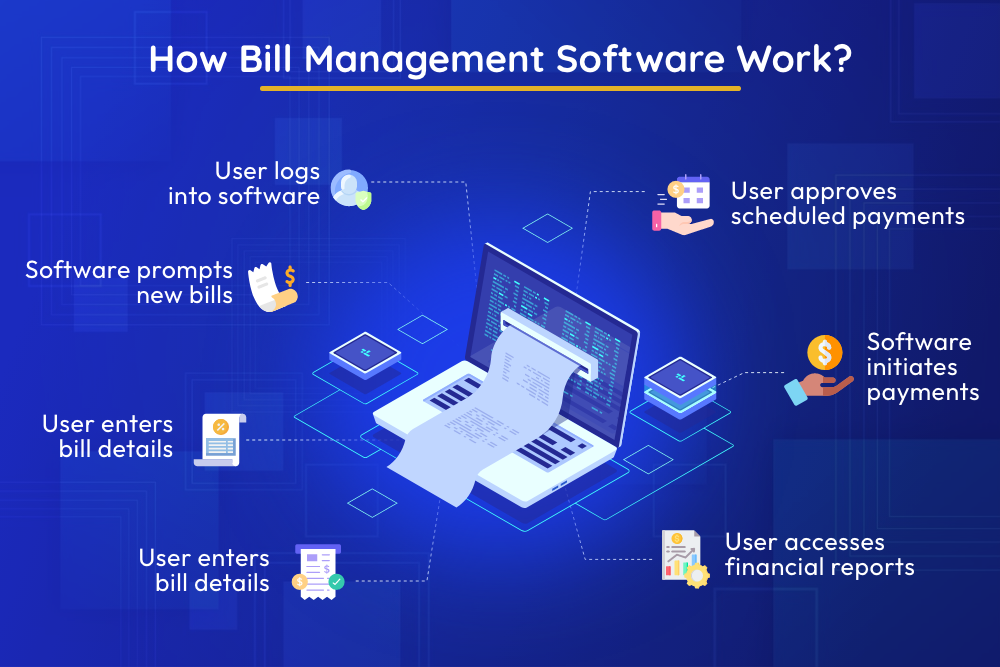
There is ample best software for billing management when integrated with online banking systems, enabling direct payments and real-time updates on financial transactions. By digitizing and simplifying the bill management process, the software enhances efficiency, reduces the risk of errors, and provides users with a more precise overview of their financial obligations.
So, suppose you are looking for a reputed software development company to help you develop a billing management system. In that case, you should know everything associated with invoicing software management.
Billing Management Software Market Growth & Statistics
The billing software market is a thriving and ever-growing industry driven by the increasing need for businesses to streamline their billing and invoicing processes. Here are some key statistics to illustrate this growth of bill management software development.
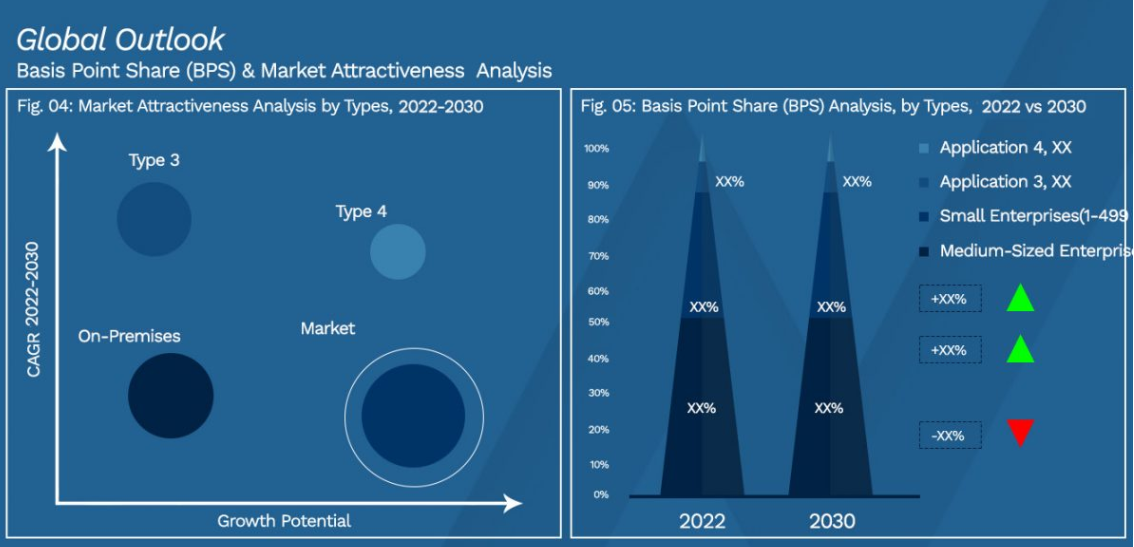
- The global online billing software is expected to reach $10.13 billion by 2027, growing at a CAGR of 1% from 2022 to 2027.
- The Asia Pacific region is expected to be the fastest-growing market due to the rapid adoption of cloud-based solutions and the increasing number of small and medium-sized businesses in the region.
- The subscription Billing Software market is expected to reach $3.42 billion by 2025, growing at a CAGR of 2% from 2020 to 2025.
- Among all, the utility billing software market is anticipated to witness a growth from $5.34 billion in 2023 to $7.83 billion by 2028, reflecting a CAGR of 95% during the forecast period from 2023 to 2028.
Read More: Best Billing Applications
List of Best Bill Management Software of 2024
Bill management software can be a lifesaver for individuals and businesses alike, helping you stay organized, save money, and avoid late fees. Here are the top 5 bill management software systems for 2024, each with its unique features.
1. Quicken
Quicken is a comprehensive personal finance software that includes features for bill management, budgeting, investment tracking, and more. It allows users to link their bank accounts to track and manage bills efficiently.
Features of Quicken Billing System Software
- Seamless account management
- Investment tracking
- Automatic budgeting
- Debt reduction tools
- Analytics & reporting
2. YNAB (You Need A Budget)
YNAB is known for its online budgeting capabilities, but it also has features for managing multiple bills on the go. It encourages users to give every dollar a job, helping to prioritize and allocate funds to bills and other financial goals.
Features of YNAB Bill Management Software
- Schedule transactions
- Expense tracking
- Zero-based budgeting
- Goal tracking
- Track bills on the go
3. Mint
Mint is a popular free budgeting tool that also helps with bill management. It can sync with your bank accounts and credit cards, categorize transactions, and provide alerts for upcoming bills. So, if you are planning to create the best billing system for small business, there is no better option than developing an app like Mint.
Features of Mint Fintech Management Software
- Account aggregation
- Bill payment reminders
- Customizable alerts
- Expense tracking
- Investment tracking
4. PocketGuard
PocketGuard is a successful billing management software development project that analyzes your spending, income, and bills to provide a clear overview of your financial situation. It helps users plan for upcoming bills and avoid overspending.
Features of PocketGuard Bill Management Software
- Bill tracking and reminders
- Budgeting & expense tracking
- Saving goals
- Smart spending analytics
- Secure transactions
5. EveryDollar
EveryDollar is the best invoice tracking software created by Dave Ramsey. It uses a zero-based budgeting approach and includes features for tracking and managing bills. The focus is on giving every dollar a specific purpose.
The software for billing incorporates the latest tools and technologies to ensure secure financing. So, if you want to develop a fintech app like Everydollar, you need to take care of such factors.
Key Features of EveryDollar Billing Management Software
- Expense tracking
- Reporting & analytics
- Invoicing and billing
- Integration with financial accounts
- Budgeting tools
Simple Steps Process For Bill Management Software Development
Well-developed billing management software streamlines billing and invoice management. Are you planning to develop bill management software? Want to know the step-by-step process of how to make billing software? Without delaying further, let’s discover the development steps one by one.

Step 1 – Define Project Goals & Requirements
Before indulging in the billing CMS software development process, clearly define your project goals and requirements. It involves a comprehensive analysis of the client’s needs and expectations. Identify the billing software functionalities, target users, and desired outcomes that lay the foundation for a successful bill management software development project.
By establishing clear project objectives, the software development team can align their efforts with the client’s vision, ensuring a more focused and effective development process.
Step 2 – Conduct Market Research & Analysis
Market research and analysis are the most crucial steps in understanding the competitive landscape and identifying opportunities for innovation. So, this step of bill management software development involves studying existing billing software solutions, analyzing market trends, and identifying potential challenges and opportunities.
You can make informed decisions that enhance the software’s market relevance and competitiveness by gaining insights into user preferences, industry standards, and emerging technologies.
Step 3 – Design the Billing Software Architecture
The software architecture serves as the blueprint for the entire billing system software. In this step, the website development company experts design the architecture of the billing software, outlining the system’s structure, components, and interactions.
It includes decisions on tech stacks, database design, and overall system scalability. A well-thought-out architecture ensures that the software is robust, scalable, and capable of meeting current and future demands.
Read More: Best Billing Applications
Step 4 – Create Bill Management Software UX/UI Design
UX/UI design is critical to create the best invoice and payment app that is functional and user-friendly. During this bill management software development step, designers focus on creating an intuitive and visually appealing interface that enhances the overall user experience.
The goal is to design a user interface that facilitates efficient navigation, minimizes user errors, and provides a visually cohesive and pleasing interaction with the software.
Step 5 – Implement Billing and Invoicing Features
With the design in place, the dedicated developers begin implementing the core billing and invoicing software features. It involves coding the functionalities outlined in the project requirements, such as invoice generation, payment tracking, and reporting.
The implementation phase requires connecting with a reliable fintech software development company to ensure the final product aligns with the initial design and meets the project requirements.
Step 6 – Begin Bill Management Software Development
This step to develop bill management software involves the actual coding and development of the billing software. Developers use the chosen technology stack to build the software’s backend and frontend components. Transparent communication and collaboration between the bill software development company and other stakeholders ensure the project stays on track.
So, if you have your team, well and good; if not, hire software developers from a leading firm.
Step 7 – Test & Launch Your Billing Software
Testing is one of the crucial phases in identifying and rectifying any bugs or performance issues in the billing management software. The quality assurance teams conduct thorough testing to ensure the software meets the specified requirements and functions as intended.
Once the testing is complete, you can launch your billing software on the desired development platform. The launch phase may involve marketing and deployment strategies to maximize visibility and user adoption.
Must-Have Features of Billing Management Software Development
Billing management software is crucial for businesses to streamline their invoicing and financial processes. Here are seven must-have features for effective billing management software development.
- Automated Bill Entry
- Expense Tracking
- Bill Payment Reminders
- Integration with Accounting Systems
- Document Storage and Retrieval
- Customizable Reporting
- Multi-User Access and Permissions
It is just a quick overview; now, let’s understand the billing software development features in detail.
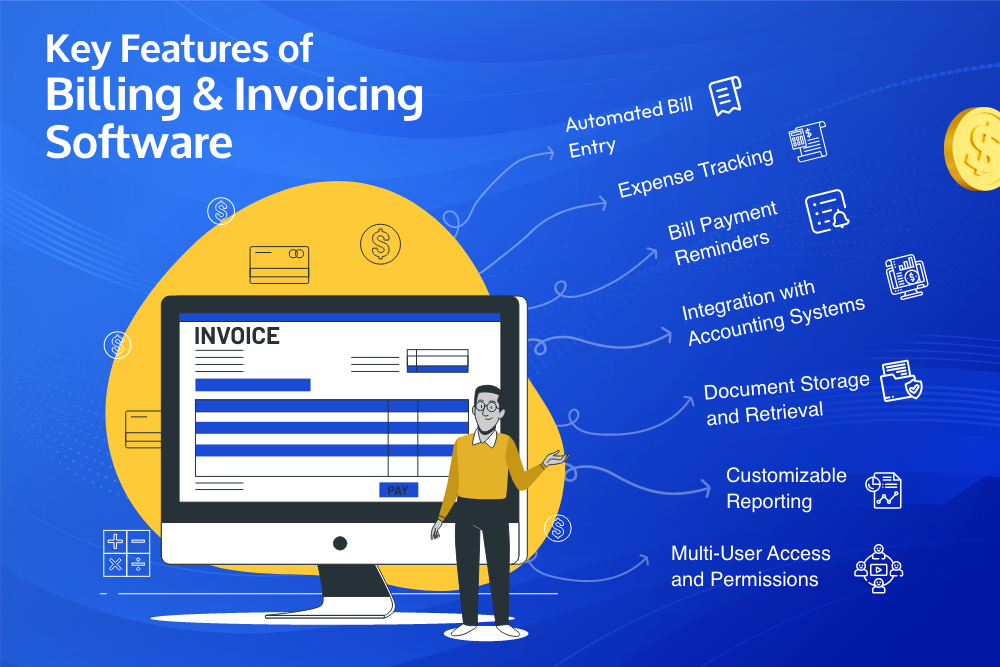
1. Automated Bill Entry
Many bill management software solutions offer automated data entry features. This functionality lets users scan or import bills and invoices directly into the bill system software.
2. Expense Tracking
The comprehensive expense tracking features of the best software for billing enable users to categorize and monitor their spending patterns. Users can create expense categories, set budgets, and receive alerts when approaching or exceeding predefined limits.
3. Bill Payment Reminders
Bill management software development often includes reminder functionalities to notify users of upcoming bill due dates. These reminders are based on user preferences, ensuring timely payments and helping users avoid late fees or penalties.
4. Integration with Accounting Systems
Integration capabilities with banking and accounting systems allow seamless synchronization of financial data. It ensures that the bill management software accurately reflects the transactions, reducing the need for manual reconciliation.
5. Document Storage and Retrieval
Many bill management solutions offer document storage features, allowing users to attach and store supporting documents directly within the software. Its centralized repository simplifies record-keeping and makes it easy to retrieve relevant documents when needed.
6. Customizable Reporting
Robust reporting tools provide users with insights into their financial activities. Customizable reports enable users to analyze spending patterns, track trends, and make informed financial decisions. Standard report types include expense reports, budget reports, and cash flow statements.
7. Multi-User Access and Permissions
For businesses or households with multiple users, bill management software often supports various user accounts with varying levels of access permissions. This feature ensures that individuals can collaborate on financial management while maintaining data security and privacy.
How Much Does Bill Management Software Development Cost?
An average cost of billing management software development begins at $8,000 and might go beyond $25,000, and more depending on the type of software developed. This is just a basic and rough cost estimation to create a billing software.
The more advanced features you will include in your billing management software, the higher will be its development cost. The final software development cost depends on the multiple factors as listed below.
Major factors affecting the cost to develop bill and invoice management software are –
- Software Complexity – The type of software and its complexity define the cost of bill management software development.
- Development Platform – Different development platforms have costs associated. So, decide the platform where you will be launching your billing software.
- Features & Tech Stacks – Every feature and software development technologies increase the cost to develop a billing management software to a great extent.
- UX/UI Design – Do not keep the design of your bill management software overly complicated as it will increase the cost of billing software development.
- Developer’s Location – The software development team’s location define the cost to create a billing software. So, when you hire dedicated developers from a leading firm, choose the location wisely.
How Much Does It Cost to Maintain A Bill Management Software?
The cost to maintain bill management software is around 15 to 25% of the overall bill management software development cost. Besides that mobile app support and maintenance services cost depends on various factors, including the system complexity, size of the user base, and the frequency of updates. Generally, maintenance expenses encompass software updates, bug fixes, security patches, and technical support.
Additionally, ongoing expenses may include server hosting, database management, and integration with other systems. It’s crucial to budget for regular maintenance to ensure optimal performance, compliance with evolving regulations, and the incorporation of new features to meet changing business needs.
Planning for Billing Software Development? You Are Just A Click Away!
Custom billing management software development goes beyond seamlessly managing the invoicing and financial issues. It proves to be a great asset for all-scale businesses while helping them manage custom relationships, track team’s productivity, and get timely updates. Overall, it is a long-term investment that can benefit businesses for years to come.
But, as developing a billing management software is not everyone’s cup of team, connect with the right software development services provider like Dev Technosys is must. With years of technical expertise and industrial experience, we have successfully developed billing and invoicing software for wide range of domains.
So, do not worry about how to create a billing software; instead, connect with us to bring your business vision to life. Feel free to discuss your idea to develop a bill management software and let our experts tackle the rest.
Frequently Asked Questions
Q1. Which is the Best Bill Management Software?
The best bill management software depends on your specific needs. Popular billing software in the market are – QuickBooks, FreshBooks, and Zoho Books, each offering unique features and pricing plans.
Q2. How Long Does It Take to Create A Billing Software?
The time to create billing software varies based on complexity. Simple systems may take a few weeks, while more intricate solutions can take several months. Customization and features also influence the development timeline.
Q3. What is the Bill Management Software Development Cost?
The development cost for bill management software varies widely. It can range from a few thousand dollars for basic solutions to a substantial investment for complex, customized software. Factors include features, complexity, and developer rates.
Q4. What Are the Benefits of Bill Management Software Development?
Bill management software streamlines invoicing, reduces errors, improves accuracy, enhances financial visibility, and saves time. It also allows for better financial data organization and ensures billing regulations compliance.
Q5. Why Choose Billing Software Development Services?
Opting for billing software development services ensures a tailored solution to meet specific business needs. Professional developers provide expertise, support, and ongoing maintenance, allowing businesses to focus on their core operations while enjoying a customized billing system.
